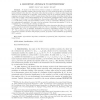Free Online Productivity Tools
i2Speak
i2Symbol
i2OCR
iTex2Img
iWeb2Print
iWeb2Shot
i2Type
iPdf2Split
iPdf2Merge
i2Bopomofo
i2Arabic
i2Style
i2Image
i2PDF
iLatex2Rtf
Sci2ools
ESA
1995
Springer
1995
Springer
A Geometric Approach to Betweenness
An input to the betweenness problem contains m constraints over n real variables (points). Each constraint consists of three points, where one of the points is specified to lie inside the interval defined by the other two. The order of the other two points (i.e., which one is the largest and which one is the smallest) is not specified. This problem comes up in questions related to physical mapping in molecular biology. In 1979, Opatrny showed that the problem of deciding whether the n points can be totally ordered while satisfying the m betweenness constraints is NP-complete [SIAM J. Comput., 8 (1979), pp. 111–114]. Furthermore, the problem is MAX SNP complete, and for every α > 47/48 finding a total order that satisfies at least α of the m constraints is NP-hard (even if all the constraints are satisfiable). It is easy to find an ordering of the points that satisfies 1/3 of the m constraints (e.g., by choosing the ordering at random). This paper presents a polynomial ti...
| Added | 26 Aug 2010 |
| Updated | 26 Aug 2010 |
| Type | Conference |
| Year | 1995 |
| Where | ESA |
| Authors | Benny Chor, Madhu Sudan |
Comments (0)

